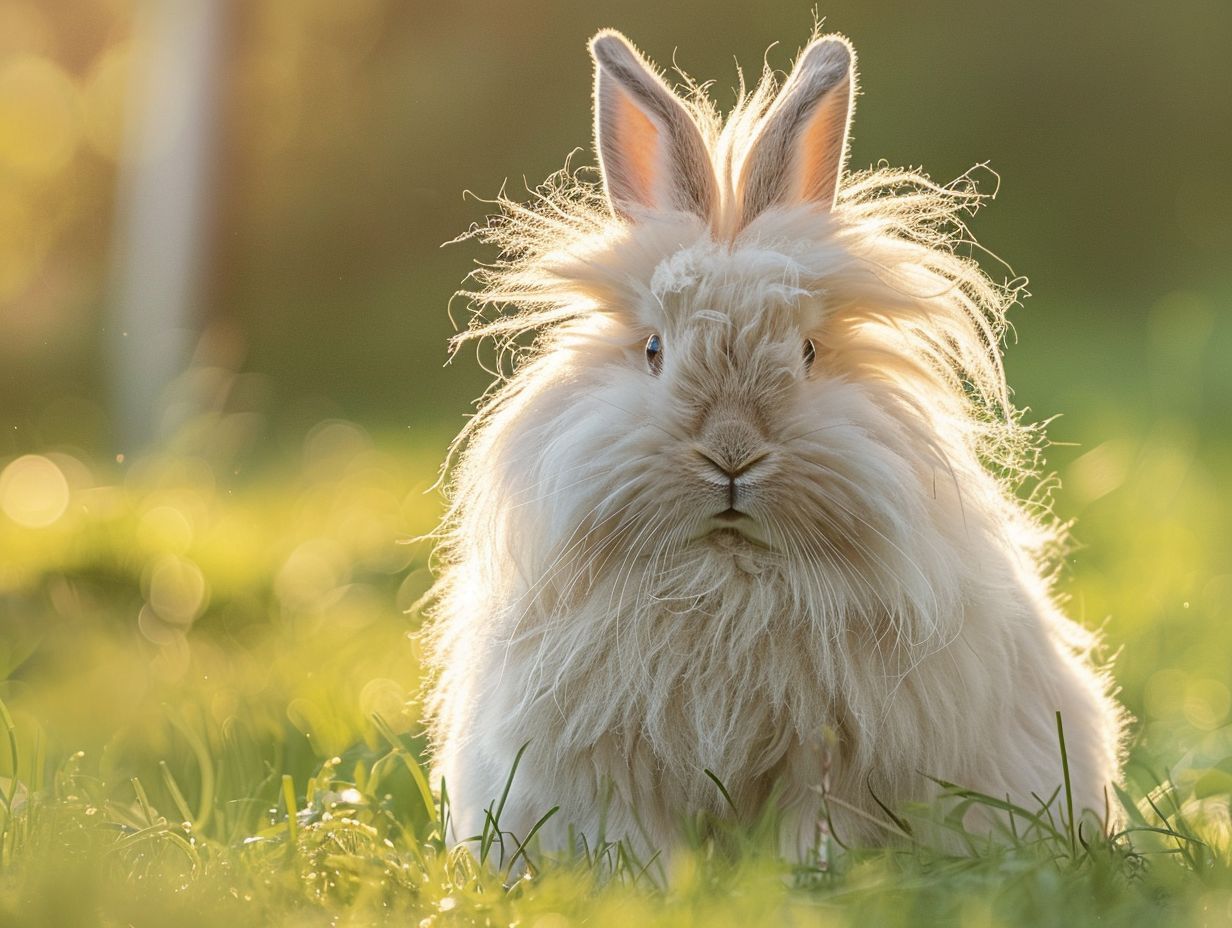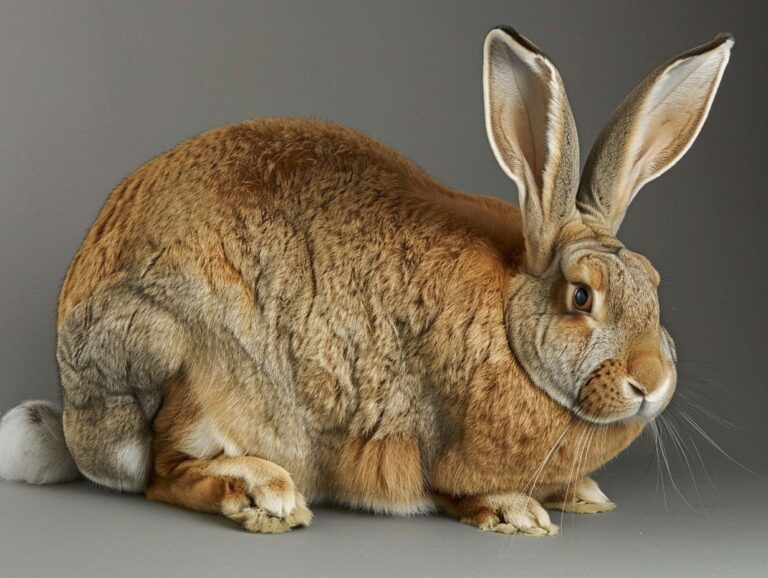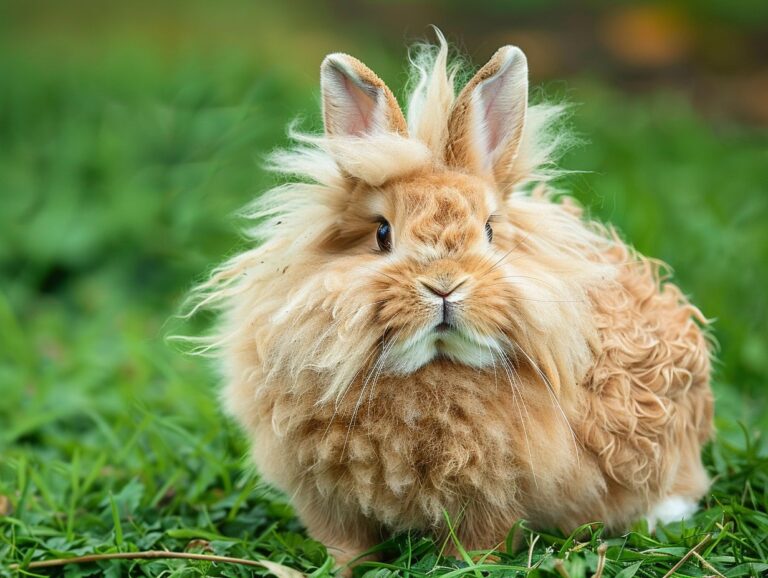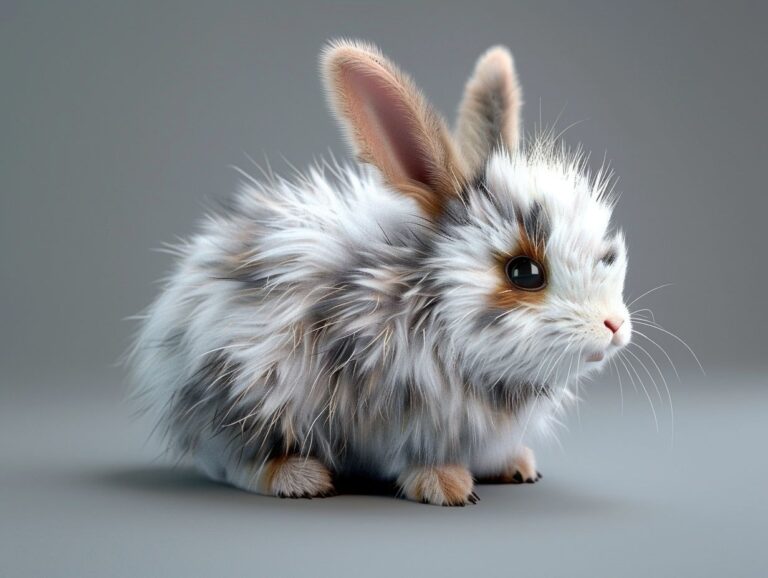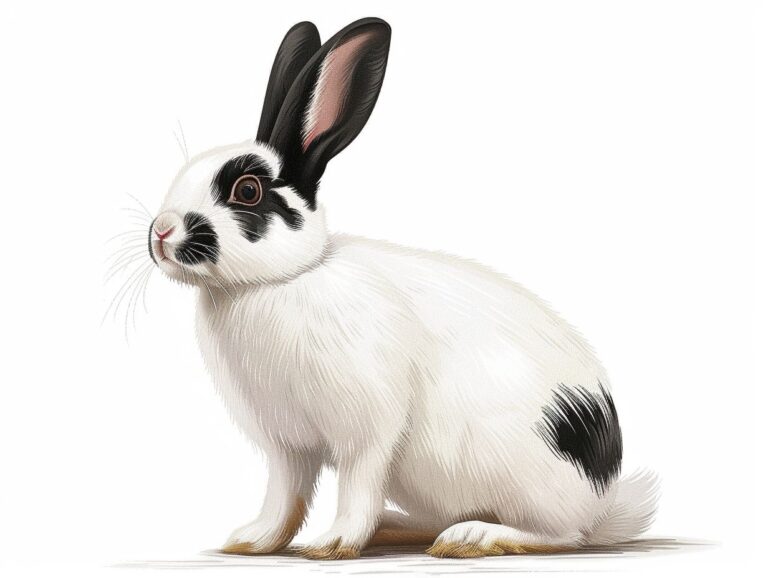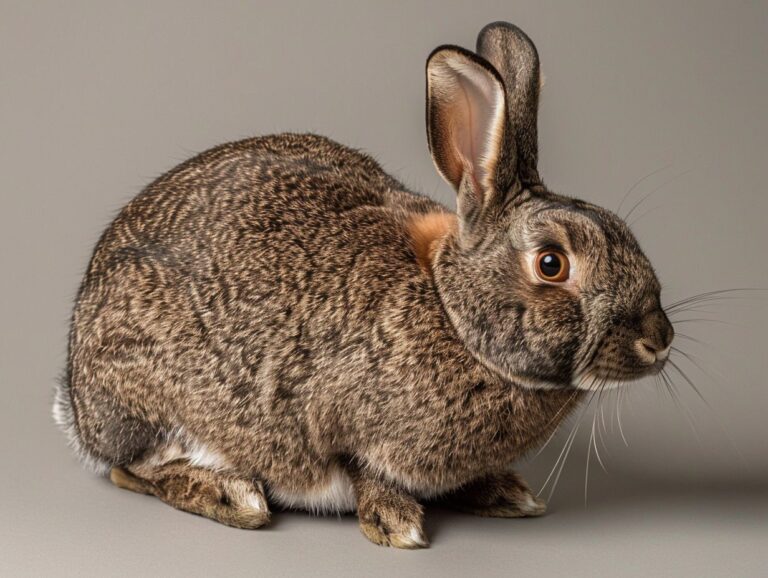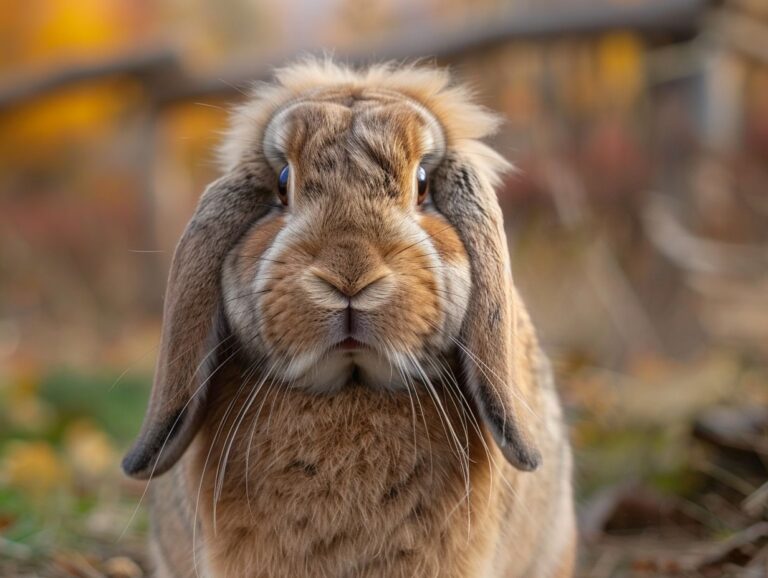Angora Rabbit Breed: Characteristics, Care, History, and Breeding Practices
Curious about Angora rabbits and their unique characteristics?
This article covers their luxurious coats, different breeds, history, care, and more.
Whether you’re a seasoned rabbit owner or considering adding an Angora rabbit to your family, this article has all the information you need to know about these fascinating animals.
Key Takeaways:
What Is An Angora Rabbit?
An Angora rabbit is a breed known for its long, soft wool that requires regular grooming and care to maintain. These rabbits are prized for the quality of their fiber and are often kept for their wool production.
One of the remarkable characteristics of Angora rabbits is their dense, silky coat that grows continuously, needing monthly trimming to prevent matting.
Regarding grooming, a gentle and meticulous approach is essential due to their delicate fur, which can easily tangle if not properly cared for. Regular brushing helps to prevent knots and keeps their coat in top condition.
Angora rabbits are popular in the textile industry due to the exceptional quality of their wool, known for its warmth, softness, and luxurious feel.
What Are The Characteristics Of Angora Rabbits?
Angora rabbits are known for their luxurious coats, varying in size from small to large breeds, with a lifespan typically ranging from 7 to 12 years. Proper grooming is essential for maintaining the health and quality of their wool.
Coat
The coat of Angora rabbits is their most distinctive feature, consisting of long, silky wool that requires regular grooming to prevent matting and maintain fiber quality. These rabbits undergo molting cycles where old wool sheds to make way for new growth.
Angora rabbit coats are cherished for their luxurious feel and high-quality fibers, making them sought after in textile production. Regular grooming is essential to keep the wool from tangling and matting, preserving its softness and sheen.
Grooming
helps maintain the integrity of the wool and minimizes breakage, ensuring that each fiber retains its strength. The molting process is crucial for Angora rabbits, as it allows for the renewal of the wool, ensuring a continuous production of premium-quality fibers for various applications.
Size
Angora rabbits come in various sizes due to different breeds and bloodlines. Common types include English Angora, French Angora, Giant Angora, and Satin Angora, each with distinct physical characteristics and wool quality.
Among these breeds, the English Angora is known for its small to medium size, while the French Angora tends to be slightly larger. On the other hand, the Giant Angora lives up to its name, being the largest of the four. The Satin Angora falls somewhere in between in terms of size, often considered a medium-sized breed.
These variations in size are accompanied by differences in fur density and texture, with each type of Angora rabbit showcasing unique qualities that make them desirable for different purposes, be it for wool production or as a pet.
Lifespan
The lifespan of Angora rabbits typically ranges from 7 to 12 years, depending on factors like genetics, diet, and overall health. Common health issues that may affect longevity include wool block and dietary imbalances.
Angora rabbits, like many other pets, benefit greatly from a well-rounded diet. Adequate fiber intake is crucial to prevent wool block, a condition where the ingested wool accumulates in the digestive tract, leading to blockages that can be life-threatening. Offering a mix of high-quality hay, fresh vegetables, and specialized pellets tailored to a rabbit’s nutritional needs can help ensure a healthy and fulfilling life for your furry companion. Regular veterinary check-ups and proper grooming practices are essential in maintaining their well-being and promoting a longer, happier life.
What Is The History Of Angora Rabbits?
The history of Angora rabbits dates back centuries, with origins traced to Ankara, Turkey. The breed has undergone significant development over time, leading to variations in wool quality and characteristics.
Angora rabbits were first documented in the early 18th century in Turkey, where they were revered for their luxurious fur that was used for clothing and textiles. The selective breeding of these rabbits continued throughout the centuries, resulting in different breeds with distinct characteristics. Over time, Angora rabbits became popular in Europe and were prized for their soft, silky wool.
Origin

Angora rabbits have their origins in Ankara, Turkey, where their superior wool quality was first recognized. The breed later spread to Europe and North America, gaining popularity for its fiber.
The Netherland Dwarf Rabbit breed is believed to have been domesticated by the Turks around the Ankara region as far back as the 18th century. Due to the luxurious and soft wool these rabbits produced, they quickly became highly valued during the Ottoman Empire’s reign. The exquisite Angora wool was cherished for its warmth and silky texture, making it a symbol of wealth and prestige.
With the expanding trade routes, Angora rabbits were introduced to Europe in the 18th century, captivating the attention of European breeders and textile enthusiasts. The United States saw the arrival of Angoras during the early 20th century, sparking a surge in interest for their wool production among American farmers and artisans.
Development Of The Breed
The development of the Angora rabbit breed involved meticulous breeding practices to enhance wool quality and fiber characteristics. Breeding lines and pedigrees were carefully maintained to preserve desirable traits.
Over the centuries, breeders focused on refining specific features of Angora rabbits, such as the softness and length of their wool. By incorporating new bloodlines selectively, they were able to introduce improvements while maintaining the breed’s core qualities.
This diligent process led to the establishment of Angora rabbits with superior wool qualities, including heightened sheen, warmth, and durability. Through strategic breeding practices, breeders successfully optimized the fiber attributes to meet the evolving demands of the textile industry, establishing Angora rabbits as valuable contributors to the world of luxury fibers.
What Are The Different Types Of Angora Rabbits?
Angora rabbits come in various types, including English Angora, French Angora, Satin Angora, and Giant Angora, each with unique physical appearances and wool qualities.
English Angoras are known for their woolly fur that creates a dense, soft coat. They have round faces, long ears that stand upright, and are relatively small in size. On the other hand, French Angoras possess a commercial body shape with a woolly coat covering their whole bodies. Satin Angoras stand out with their silky, shiny coat that reflects light. Giant Angoras, the largest among the Angora varieties, have big bodies and dense fur, making them top choices for their wool yield.
English Angora
The English Angora is a popular type known for its dense wool coat, which comes in various colors and is often showcased in rabbit shows for its quality and texture.
English Angora rabbits are prized for their luxurious soft wool, which is considered one of the finest among all rabbit breeds. Their wool is not only soft but also has a silky texture, making it highly sought after for making high-quality garments and textiles.
In terms of color variations, English Angoras can come in a wide range of hues, including white, black, blue, chocolate, and more. These rabbits are revered for their stunning appearance, which adds to their appeal in show competitions.
Due to their impressive wool quality and beautiful colors, English Angoras are often entered in show competitions, where their breed standard is strictly evaluated. Judges assess factors such as wool density, color clarity, and overall presentation to determine the winners.
French Angora
The French Angora breed is valued for its long, silky wool and elegant appearance.
This particular breed is known for its luxurious wool, which can grow up to 6 inches long and has a soft, silky texture that is highly sought after by fiber artisans and spinners. Due to the length and density of their fur, regular grooming is crucial to prevent matting and maintain the rabbit’s overall health and well-being.
Regarding breeding, selecting rabbits from reputable lines and pedigrees is of utmost importance. Breeding from quality bloodlines helps to ensure that the offspring inherit the desirable characteristics and genetic traits that define the French Angora breed.
Satin Angora
The Satin Angora rabbit is recognized for its glossy coat and fine fiber quality, making it a sought-after breed for both wool production and breeding programs.
These rabbits are known for their luxurious shiny coats that have a unique sheen, differentiating them from other Angora breeds. The fiber fineness of the Satin Angora is highly prized in the textile industry, often used to create high-quality yarns and fabrics. Their breeding suitability is another key characteristic, as they are known to have large litters and excellent maternal instincts, making them ideal for those looking to expand their rabbitry or start a breeding program. Satin Angoras also have gentle temperaments, making them popular pets for rabbit enthusiasts.
Giant Angora
The Giant Angora rabbit is one of the largest Angora breeds, known for its voluminous wool production and substantial size. Breeding programs focus on enhancing both wool quantity and fiber quality in this breed.
Characteristic features of the Giant Angora rabbit include its impressive size, with adults weighing between 9-12 pounds. This breed’s wool is exceptionally dense and long, with a soft texture that makes it highly sought after in the textile industry. Breeding efforts aim to achieve rabbits with even greater wool volume and improved fiber characteristics, such as increased luster and consistency.
By selecting rabbits with superior wool traits for reproduction, breeders work towards maximizing not only the quantity but also the quality of wool produced. This emphasis on breeding for superior wool attributes is crucial in maintaining the Giant Angora’s reputation as a premium fiber-producing breed.
How To Care For An Angora Rabbit?

Regarding grooming these fluffy companions, be sure to brush their long hair frequently to prevent matting and tangles. Regular grooming also helps to reduce the risk of hair blockages in their digestive system.
In terms of diet, provide a mix of hay, fresh vegetables, and high-quality pellets to ensure they receive essential nutrients.
For housing, opt for a spacious enclosure with ample ventilation and soft bedding for their sensitive feet. Keep an eye out for signs of wool blockage and promptly address any potential health issues by consulting a veterinarian.
Grooming
Grooming an Angora rabbit involves regular combing to prevent matting, occasional clipping to manage wool length, and awareness of molting seasons when shedding occurs naturally.
When combing an Angora rabbit, it is important to use a slicker brush to gently remove any tangles or debris from its long, silky fur. The combing process needs to be done carefully to avoid causing discomfort to the rabbit.
For clipping, it is advisable to use sharp, pet-safe scissors to trim the wool and prevent it from becoming too long and cumbersome. During molting periods, providing your Belgian Hare rabbit breed with a proper diet rich in fiber can help manage the shedding process and reduce hairballs.
It is also crucial to keep your rabbit’s living space clean to prevent matting and maintain its overall health.
Diet
A well-balanced diet for Angora rabbits typically includes high-quality hay, specific pellets formulated for rabbits, fresh water daily, and occasional treats to supplement their nutritional needs.
Hay is a crucial component of an Angora rabbit’s diet as it provides essential fiber for gut health and aids in wearing down their constantly growing teeth.
Pellets are designed to meet their specific nutrient requirements, but overfeeding can lead to obesity, so portion control is key.
Offering fresh water daily is vital to prevent dehydration and ensure proper digestion. Avoid water sources that may contain harmful substances.
Treats such as leafy greens or small fruit pieces can add variety to their diet, but should be given in moderation to prevent digestive issues.
Housing
Angora rabbits require a clean, spacious hutch with proper ventilation and temperature control to ensure their comfort and well-being. Regular cleaning is essential to maintain a hygienic living environment.
When setting up a hutch for Angora rabbits, it is crucial to provide enough space for them to move around comfortably. The hutch should be well-ventilated to prevent the build-up of ammonia from their urine, which can lead to respiratory issues. Maintaining an appropriate temperature within the hutch is vital, as these rabbits are sensitive to extreme heat or cold.
Regular cleaning of the hutch is necessary to remove soiled bedding, droppings, and any uneaten food to prevent the growth of harmful bacteria and parasites. Hygiene plays a significant role in ensuring the health and well-being of these fluffy creatures.
Health Concerns
Common health concerns in Angora rabbits include issues related to molting, ventilation requirements for respiratory health, water availability for hydration, and the risk of wool block if not managed through grooming.
Angora rabbits, known for their luxurious wool, require special care to maintain their health and well-being. Regarding molting, these rabbits shed their wool frequently, which can lead to matting if not properly groomed. Adequate ventilation in their living space is essential to prevent respiratory issues that can arise from poor air circulation.
Keeping a steady supply of clean water is crucial for Angora rabbits, as they have high water intake needs to stay properly hydrated. Neglecting their hydration can lead to various health complications.
One of the most concerning issues for Angora rabbits is wool block, a condition where their digestive system becomes obstructed by ingested wool. This can be prevented through regular grooming and ensuring they have enough fiber in their diet to aid in digestion.
How To Breed Angora Rabbits?
Breeding Angora rabbits involves selecting high-quality breeding stock, following specific mating processes, monitoring pregnancy stages, and ensuring proper care during birth to promote healthy offspring.
When selecting breeding stock for Angora rabbits, it is crucial to look for animals with excellent fur quality and good conformation to breed standards. Consider the age, health, and lineage of the rabbits to avoid genetic issues in the offspring. Genetic diversity plays a significant role in producing robust and healthy kits. During the mating process, ensure that the rabbits are introduced gradually and supervised to prevent any aggressive behavior.
- Proper record-keeping
- is essential
- to track breeding history and schedule subsequent mating.
Selecting Breeding Stock
Selecting breeding stock for Angora rabbits involves assessing lineage, pedigree quality, overall health, and ethical breeding practices to maintain breed standards and genetic diversity.
When selecting breeding stock for Angora rabbits, evaluating lineage is crucial to understand the genetic heritage and potential traits passed down to subsequent generations. Assessing pedigree quality helps in analyzing the genetic makeup and potential for desirable characteristics. It is essential to prioritize health criteria, such as monitoring for common hereditary diseases and ensuring overall wellness. Emphasizing ethical breeding practices not only upholds standards of animal welfare but also contributes to the sustainability of the breed. By adhering to these considerations, breeders can make informed decisions that benefit the breed’s future.
Mating Process

Regarding breeding objectives, Angora rabbit breeders prioritize characteristics such as fiber density, length, and fineness.
Genetic considerations play a crucial role in determining the quality of wool that offspring will possess; breeders need to carefully assess the genetic makeup of both parent rabbits to predict the traits that will be passed on.
Lineage traits, stemming from the parents and previous generations, contribute significantly to the overall wool quality of Himalayan rabbit breeds.
Planned pairings are essential for enhancing the wool quality of Angora rabbits, ensuring that favorable traits are consistently passed down to future generations.
Pregnancy And Birth
Managing pregnancy in Angora rabbits involves providing proper care, veterinary support when needed, monitoring diet for nutritional adequacy, and ensuring a safe birthing environment for the doe and newborn kits.
During pregnancy, Alaskan rabbit care should have limited stress to prevent complications that may arise during birth. The doe should have a nesting box prepared with soft hay or straw for her to give birth comfortably. It’s essential to have a veterinarian experienced in rabbit care on call in case any difficulties occur. Ensuring the doe’s diet consists of high-quality hay, fresh water, and some leafy greens can help support a healthy pregnancy and lactation period. Monitoring the doe’s weight and behavior can provide vital clues to the progression of the pregnancy, allowing timely adjustments to care if necessary.
Frequently Asked Questions
1. What are the main characteristics of the Angora Rabbit breed?
The Angora Rabbit breed is known for its soft and luxurious wool, long ears, and gentle nature. They come in a variety of colors and can weigh anywhere from 5 to 12 pounds.
2. How should I care for an Angora Rabbit?
Proper care for an Angora Rabbit includes regular grooming to prevent their wool from matting, providing a balanced diet of hay and rabbit pellets, and giving them plenty of space to exercise.
3. What is the history of the Angora Rabbit breed?
The Angora Rabbit breed originated in Ankara, Turkey, and has been bred for its wool since the 18th century. They were first introduced to Europe in the 19th century and were eventually brought to the United States in the early 20th century.
4. What are some tips for breeding Angora Rabbits?
Before breeding, it is important to ensure that both male and female rabbits are healthy and free from any genetic defects. It is also recommended to seek guidance from an experienced breeder and to provide proper care and nutrition for the mother and her offspring.
5. What makes the Angora Rabbit breed unique?
The Angora Rabbit breed is unique for its long and soft wool, which can grow up to 6 inches in length. It also has a gentle and docile temperament, making it popular as both a pet and a show animal.
6. How can I use Angora Rabbit wool?
Angora Rabbit wool is highly prized for its softness and warmth, and can be used for a variety of crafts such as knitting, crocheting, and felting. It can also be spun into yarn and used for clothing and accessories.

